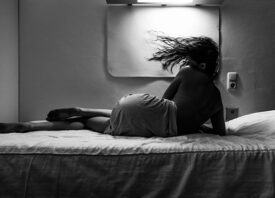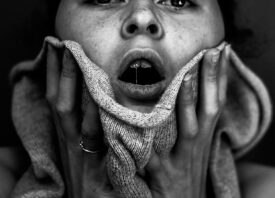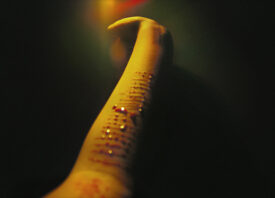Search this site
One Photographer’s Fearless Look at Eating Disorders

C. decided that the burn marks on her belly function well as a symbol for her experience: “I am always cold. Always…that’s why I never sleep without a hot-water bottle. Sometimes it’s just too hot, though, and then it leaves these marks…”

J. is a young student living in Vienna, Austria. She suffered from Bulimia for almost 6 years but finally succeded in overcoming the illness after a long-term stay in a local clinic. She regularily attends a self-help group to talk with others who are currently struggling with eating disorders. Listening to her optimistic and strong statements often gives the other participants the courage to work further towards self-appreciation and acceptance. J. is an inspirational person for many of them. She preferred to remain anonymous on the photographs. J. has a very strong connection to water, which is why we decided to have her photographs taken in a swimming pool.
Vienna photographer Mafalda Rakos understands that eating disorders are often cloaked in a shroud of silence and shame, but she also knows that talking about these illnesses is the only way to heal.
I want to disappear – Approaching Eating Disorders is the result of a collaboration between the photographer and the women who trusted her to tell their stories.
Rakos met most of her protagonists— she does not call them “subjects”— through a self-help group for those in the midst of or in recovery from eating disorders. Some were friends before the book project even started. Everyone included had a say on how much or how little she wanted to participate; if someone wanted to stay anonymous, the photographer abided by her wishes.
“I tried to be as sensitive and respectful as I could,” Rakos explains, “A ‘No’ could not be turned into a ‘Yes,’ no matter how much I would have liked them to dig deeper.”
For the most part, the women were eager to share this part of their lives with the photographer. The mainstream media, Rakos says, represents eating disorders in ways that aren’t always fair or accurate, and the women in I want to disappear were thankful for the chance to be honest about what they endured.
It’s not just about “being thin,” the photographer stresses. Eating disorders, like addictions, are the result of complicated events, traumas, and chance occurrences. “It comes from what happens in your mind,” Rakos suggests, “not really in your body.”
When asked about the most powerful memory she’s carried over the course of making the work, the photographer mentions a picture that never made it into the book. There was one woman who made drawings and sculptures, and in her artwork, there was always a mysterious shadowy figure in the back.
She told Rakos that the figure represented her “her own self-disgust.” The two of them eventually staged a photograph in which the woman confronted the figure, played by a man dressed in black clothes.
The project was painful and emotionally taxing at times, and Rakos admits she might have allowed herself to give up if not for a grant given to her by Documentary Project Fund. But it wasn’t just that sense of responsibility that motivated her to continue. “There was also something else,” the artist says.
Rakos felt in her core that this was a story that needed to be told, and in the end, she believes speaking out might well have helped the women in the book to repair some of what’s been lost. On the part of both the photographer and her protagonists, the book became “an attempt to point out that something is not okay at all.”
I want to disappear will be published in the fall of 2017. Follow the project on Facebook.

Picture taken by one of the protagonists. “I took this photograph to document what I look like now. I want to compare it to my body when I lost weight.”

C. has been suffering from bulimia for almost 5 years. She already experienced several long-term stays in clinical institutions which helped her to cope with her illness; nevertheless, healing still seems far away. “It’s really like an addiction. I actually don’t care so much about what I look like…but this binging-purging ritual…I feel that somehow it helps me to grapple with all these things that are constantly going on around me.”

Picture taken by a protagonist. “For me, it shows the ambivalence of food and eating in general. I think the knives look very brutal. It’s like fighting yourself every time you eat a piece of bread or something.”

Picture taken by one of the protagonists.

Picture taken by one of the protagonists.

S. in her parents house in Cologne.
All images © Mafalda Rakos
via lensculture



